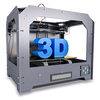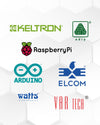
The Ultimate Arduino Tutorial for Beginners - Basics & Programming
Welcome to the other side, Makers!
You have just ordered your very first Arduino board and are looking for a tutorial that is going to change your life around, aren’t you?
If you haven’t ordered one yet and dream about owning one for yourself, you should head over to our online store and get one right away. We have some of the best prices on Arduino Boards online in India.
Don’t let the questions that you have around Arduino Programming scare you from getting started. This post is dedicated to help you with the basics of Arduino and guide you towards your very first project. Sounds exciting, doesn’t it? Let’s get started.

The Arduino, What Is It?
We start with the age-old questions, ‘What is Arduino?’ and ‘Why is it so popular’?
Arduino is an extremely easy-to-use open source platform that can be used for various electronic projects. The fact that it is very easy to get started with Arduino boards has made it one of the most widely used DIY platforms around the world. There are also a lot of helpful communities and forums that help you out if you get stuck.
How does an Arduino board work?
It’s simple really. It reads an input signal and generates an output. For example, you can turn on an LED with a mere finger on a button. Yes, we know what you are thinking. The possibilities are endless!
An Arduino board is made up of a microcontroller, a physical programmable circuit board and a software (Integrated Development Environment) that can be used to write code onto the Arduino from your computer. To load code to your Arduino, all you have to do is connect the USB cable and you’re good to go.
You can code in your project actions to make your Arduino perform exactly what you want to do using the Arduino Programming Language and the Arduino Software.
You get it. These boards are pretty great but you’re still considering maybe using another platform for your project. Let’s take a look at why it trumps all the other platforms and change your mind for good!
What Makes Arduino So Special?
Easy on your Wallet
Arduino boards are way less costly than other microcontroller platforms. If you are a beginner there are a lot of starter kits that set you on your way to becoming an expert. You can get an Arduino Uno board, one of the most popular Arduino boards for as little as Rs 400.
Operating system who?
Have no fear, these boards are cross-platform in nature. Whether you have a Windows, Mac or Linux operating system, they work like a charm.
Easy to get started & massive following
Beginners have rated this board one of the easiest to get started with. You can complete starter projects with very little hands on experience with Arduino starter kits. The community backing behind this platform is quite unbelievable which makes it super simple to find help online.
Open Source & Beautiful
The Arduino software has an open source license! Pretty wicked right? This means that if pick up other programming languages (like C or C++) you can easily extend the platform to solve complex problems.

The Hype around Arduino Uno
Arduino Uno is hands down one of the most popular Arduino boards. The simplicity, the following and a large number of online forums and communities make it THE GO TO BOARD for beginners.
At Tomson Electronics, we love the Uno and we want more of our community to get down and get started with their projects which is why we make it available for you at great prices.
There are also a lot of starter projects that you can find online to get started with Arduino Uno. This great post by Interesting Engineering lists out 17 great projects & courses that you can try out to sharpen your skills.
Arduino Uno Specification & Power Supply
Interested in learning more about the specifications of the Uno board? Don’t worry we’ve got you covered. If you aren’t interested in jumping into the specifications just yet, we suggest you skip out on this section right now.

|
Microcontroller |
|
|
Operating Voltage |
5V |
|
Input Voltage (recommended) |
7-12V |
|
Input Voltage (limit) |
6-20V |
|
Digital I/O Pins |
14 (of which 6 provide PWM output) |
|
PWM Digital I/O Pins |
6 |
|
Analog Input Pins |
6 |
|
DC Current per I/O Pin |
20 mA |
|
DC Current for 3.3V Pin |
50 mA |
|
Flash Memory |
32 KB (ATmega328P) of which 0.5 KB used by bootloader |
|
SRAM |
2 KB (ATmega328P) |
|
EEPROM |
1 KB (ATmega328P) |
|
Clock Speed |
16 MHz |
|
LED_BUILTIN |
13 |
|
Length |
68.6 mm |
|
Width |
53.4 mm |
|
Weight |
25 g |
Your Arduino board can be powered up and brought to life via a USB connection or an external power supply.
The power source is selected automatically. External (non-USB) power can come either from an AC-to-DC adapter (wall-wart) or battery. The adapter can be connected by plugging a 2.1 mm center-positive plug into the board's power jack.
Leads from a battery can be inserted in the GND and Vin pin headers of the POWER connector. The board can operate on an external supply from 6 to 20 volts. If supplied with less than 7V, however, the 5V pin may supply less than five volts and the board may become unstable. If using more than 12V, the voltage regulator may overheat and damage the board. The recommended range is 7 to 12 volts.
The power pins are as follows:
- Vin - The input voltage to the Arduino/Genuino board when it's using an external power source (as opposed to 5 volts from the USB connection or another regulated power source). You can supply voltage through this pin, or, if supplying voltage via the power jack, access it through this pin.
- 5V This pin outputs a regulated 5V from the regulator on the board. The board can be supplied with power either from the DC power jack (7 - 12V), the USB connector (5V), or the VIN pin of the board (7-12V). Supplying voltage via the 5V or 3.3V pins bypasses the regulator, and can damage your board. We don't advise it.
- 3V3 - A 3.3 volt supply generated by the onboard regulator. The maximum current draw is 50 mA.
- GND - Ground pins.
- IOREF - This pin on the Arduino/Genuino board provides the voltage reference with which the microcontroller operates. A properly configured shield can read the IOREF pin voltage and select the appropriate power source or enable voltage translators on the outputs to work with the 5V or 3.3V.
Create Circuits using an Arduino Breadboard
You can easily create prototypes for your projects using an Arduino breadboard. Experiment on different types of circuit design and be able to find the best one to move forward with your project using a breadboard.
The biggest advantage that a breadboard gives you is the flexibility of choice. So if you are obsessed with perfecting your project, the board will be your loyal companion.
They work together with their closest Ally - Jumper wires, to complete your prototypes. These wires are used for powering up the breadboard and also completing the circuit by connecting resistors, switches and other components together.
Here’s how a completed circuit looks with an Arduino Board, Arduino Breadboard and connecting wires. Elegant isn’t it?

Find out more on how you can work with Arduino Boards and Breadboards. Master the craft!
Introduction to Programming your Arduino Board
Now comes the most interesting bit, programming your board and powering it to solve problems. Follow the steps given below, young one, and you will, without a doubt learn how to create a skeleton for your program.

Step 1 - Install the Arduino Software
The Arduino software is open source in nature, which means that anyone can download it. What’s better is the fact that it works across platforms so you can work on it from a Linux, Windows or Mac operating systems.
Download Arduino Software form over here to get started.

Step 2 - Initial Set Up
Once, you have downloaded the software it’s time to do the basic set-up. You can do this by going to the Tools Menu and Selecting the board that you wish to work with.

Step 3 - Get Coding
You can use the C++ programming language to write your code. Every program that you write is called a sketch (Well, because writing program is like art isn’t it).
There are two void functions used in every program. Setup and Loop.
The setup function runs when the Arduino board powers up and is used for specifying the initialization parameters for the board.
The loop function executes the code that you want to execute, over and over again. Once you write the code based on your project requirement, the next step is to compile your code.
Step 4 - Compile your Code
Once you have completed coding your project you can go ahead and compile the code. This can be done by following these 5 steps:
- Head over to the Tools Menu and select the Serial Port option, take a look at the options that you see
- Connect your Arduino board to the computer using a USB cable
- Go back to Serial Port under the Tools menu and find the new options that appear
- Select one of the two new options from the list
- Press the button that shows an arrow pointing to the right from the screen that opens up


You have now compiled your code & your Arduino project is ready for execution.
Starter Projects for your Arduino Uno
Are you aching to get started on your very first Arduino project? We are here to help. We have listed out 3 projects that we think are great for beginners. So what are you waiting for? Jump on the bandwagon and join the Arduino collective
Thermometer with a twist - Circuito.io
Circuito.io has a great collection of products for the Makers at heart. If you are just getting started with Arduino programming then we suggest you take a loooong look at some of the resources that are available over there.
Who hasn’t come across a thermometer? Now you can make one for yourself with your very own Arduino board. All you need to get started with this project is:
- Arduino Uno
- DS18B20 – One Wire Digital Temperature Sensor
- 7-Segment Serial Display
You can find out how more information about this project here on this list of top 10 projects for Arduino Beginners!
Home Alarm System - MakeUseOf
Makeuseof, which is a great resource for beginners has come up with this gem of a project. Use your Arduino board to create a home alarm system out of scratch. Secure your home and keep the intruders at bay.
What will you need for this project?
- An Arduino
- Ultrasonic Ping Sensor
- A Piezo Buzzer
- Led Strip
Find out more on how you can make this Alarm System over here.
Solar Tracking System - Electronics Hub
Electronics Hub is another great inventory for Arduino projects and the best part is that they provide the code along with the project. In this particular project, you will learn how to create a Solar Tracking System. Modern tracking systems tend to move along with the sun’s motion, and this one does too.
What will you need for the project?
- An Arduino
- Two Servo Motors
- Light Sensor Consisting of four LDR’s
You can read up on how you can complete this project over here!



